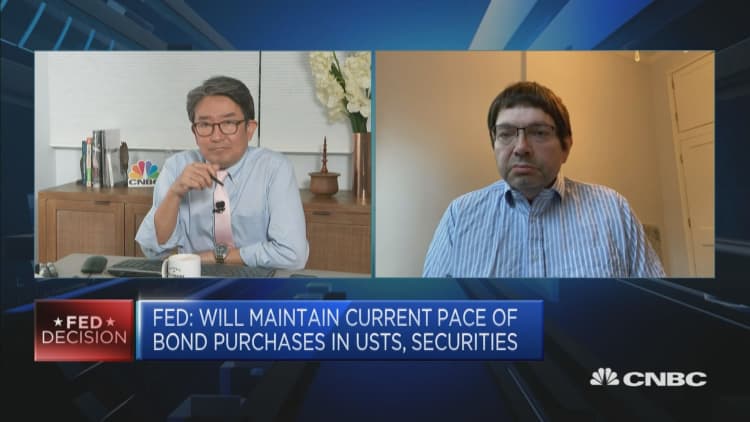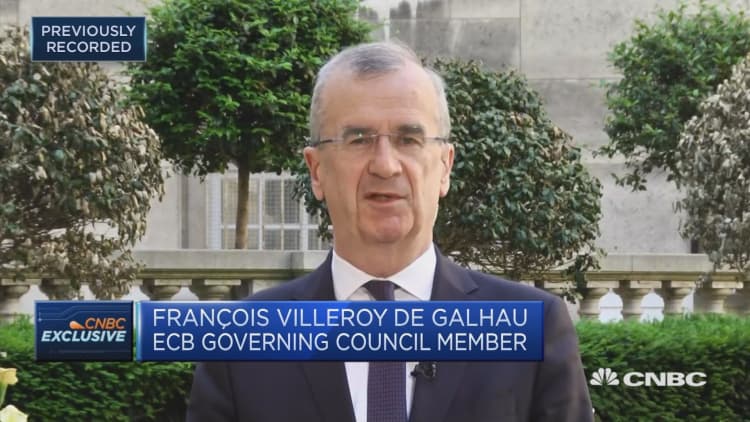As the coronavirus pandemic threatens the global economy, the debate over whether negative interest rates could spur economic growth has once again come to the forefront.
Much of that discussion in recent months has centered on whether the U.S. Federal Reserve should adopt negative rates — a policy that several of its counterparts, including the European Central Bank and Bank of Japan, have maintained for years.
But even as the U.S. faces one of its worst economic recessions in history, the Fed has — so far — steered clear of negative interest rates.
"We don't think that's an appropriate tool here in the United States," Fed Chairman Jerome Powell said last month in a webcast with Alan Blinder, a Princeton University economics professor and former Fed vice chair.
"I would say the evidence on whether it actually works is mixed," Powell added. "There are clearly some negative side effects, as there sometimes are with these things, and it's just not clear to my colleagues and to me on the Federal Open Market Committee that this is a tool that would be appropriate to deploy here in the United States."
Instead, the Fed has kept its benchmark policy rate at close to zero since March — and indicated that's where rates will stay until the U.S. economy recovers — while significantly expanding its asset purchase program.

Unconventional monetary policy
Interest rates are one of the tools that central banks use to achieve economic objectives such as low unemployment, manageable inflation and sustainable growth.
Most central banks around the world adjust a so-called policy rate, which generally refers to the interest rate on funds that commercial banks park with the central bank. That in turn influences other interest rates in the wider economy such as those on loans and deposits. It also affects bond prices, which move inversely to interest rates.

Lowering a policy rate would typically slash lending and deposit rates, which then encourage businesses and individuals to invest and spend more — actions that help the economy to grow.
Negative interest rates should — in theory — have the same effect. Some economists said that when commercial banks have to pay to deposit funds with the central bank, instead of earning an interest on those reserves, they should be encouraged to loan out that money instead.
But others pointed out that there was no certainty that negative interest rates would work as intended. They argued that commercial banks would lose a major source of funding if they impose negative rates on depositors, and in turn have less money to lend. That's because companies and individuals would rather hold cash – which costs nothing – than pay to park their money in the bank.

Both of those theories were put to the test in the years after the global financial crisis. Facing still-sluggish economic growth even after slashing policy rates to zero, several central banks turned to what was considered unconventional monetary policy. That includes negative interest rates.
Central banks that went the route of negative rates include the Swedish Riksbank, the European Central Bank, Swiss National Bank, Denmark's Danmarks Nationalbank and Bank of Japan.
Riksbank exited that policy when it moved its benchmark rate to zero last December.
Profitability of banks
Over the last few years, economists have conducted several studies on the effectiveness of negative interest rates. But the findings have so far been mixed, with no clear conclusion on whether or not the policy has worked.
Some studies found that not only did negative interest rates not work in some European economies and Japan, they also reduced bank profits. That happened because banks were reluctant to move deposit rates below zero, which would reduce their funding. But by not charging depositors, profits suffered because banks were earning less on loans, according to the studies.
There are clearly some negative side effects, as there sometimes are with these things, and it's just not clear to my colleagues and to me on the Federal Open Market Committee that this is a tool that would be appropriate to deploy here in the United States.Jerome Powellchairman of Federal Reserve
"If they're unwilling to lend because there's no profit in doing so, then they're not going to. As a result, you don't really have the investment, you don't have the credit creation," Jim Caron, a portfolio manager at Morgan Stanley Investment Management, told CNBC's "Squawk Box Asia" last month.
Banks play an important role in growing the economy: Money they lend helps companies to expand their operations, and households to increase their wealth. Any scaling back of bank lending could hamper economic growth.
Other studies found that banks, wanting to boost profits, concentrated their lending to riskier firms, which could increase the risk of financial crises.
Negative interest rates have both adverse and beneficial effects on bank profitability, and the net effect is ultimately an empirical question.European Central Bank
"Our results suggest that negative rates are less accommodative, and could pose a risk to financial stability, if lending is done by high-deposit banks," read the abstract of a working paper published in August 2018 by the European Central Bank.
High-deposit banks are those that have a greater reliance on deposits as a source of funding, according to the authors of the paper, who were from the ECB and Stockholm School of Economics.
Not all bad
But there are also ways that negative rates could support bank profits, according to an ECB bulletin published last month. The bulletins, published eight times a year, outline information that forms the basis for the ECB's policy decisions.
The central bank explains how banks can benefit from a negative policy rate:
- Better macroeconomic conditions could increase banks' business volume;
- Improved outlook and lower rates help boost creditworthiness of borrowers, which reduce costs for banks;
- Securities held by banks may increase in value.
"Negative interest rates have both adverse and beneficial effects on bank profitability, and the net effect is ultimately an empirical question," read the ECB bulletin.
Time for the Fed to go negative?
Voices advocating for the Fed to adopt negative interest rates have grown louder in recent months.
The coronavirus pandemic has severely hit the U.S. economy, which is the world's largest. The Fed projected that the U.S. economy could shrink by 6.5% in 2020 — which would be one of the country's worst economic performances ever.
Kenneth Rogoff, an economics and public policy professor at Harvard University, argued in a May article that "only a policy of effective deep negative interest rates" could lift the U.S. economy out of the doldrums. But policymakers must first prevent cash hoarding, he added.
"It is not rocket science," wrote Rogoff. "With large-scale cash hoarding taken off the table, the issue of pass-through of negative rates to bank depositors — the most sensible concern — would be eliminated."

In fact, an economist at the Federal Reserve Bank of St. Louis said a combination of negative interest rates and aggressive government spending could be what's needed to stimulate the U.S. economy.
But some investors and analysts maintained that the limited evidence that negative interest rates have worked and the potential harm to the economy are reasons why the Fed shouldn't adopt the policy.
Vishnu Varathan, head of economics and strategy at Japanese bank Mizuho, wrote in a note in response to Rogoff's article that "negative rates are clearly not that positive."
He explained that while all interest rate cuts benefit borrowers at the detriment of savers, "negative rates take this to the extreme" by severely eroding pensions. He added that such a policy would also incite a reckless chase for returns, which could cause the next financial crisis.
"Fact is, the evidence on the efficacy of negative rates is at best mixed, while the costs are undeniably high," said Varathan. "The hope is that the Fed is wary of the serious drawbacks from negative rates."


